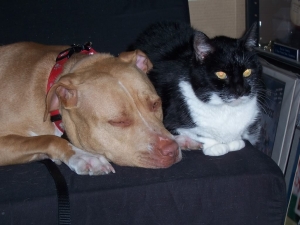
July 01, 2010
Bully For You! - The Ezine for Pit Bull Lovers
July 2010 Volume 4
Paws-i-tive Press: The Vicktory Dogs
What's New at The Proper Pit Bull
Feature Article: Can We Be Friends? Pit Bulls and Cats
Quote of the Month
Paws-i-tive Press
Only one was euthanized for being too aggressive. Another had to be euthanized for health reasons. Nearly half of the remaining 47 found asylum at Best Friends Animal Sanctuary in Kanab, Utah where they can live out their lives if need be. The rest went to rescues like San Francisco's BAD RAP (Bay Area Dog Lovers Responsible About Pitbulls) and Recycled Love in Baltimore. A number of these dogs have found loving homes and a few have even gone on to compete in agility or become certified therapy dogs.
To appreciate what a triumph this is, it's important to point out that none of the "big players" in animal welfare thought these dogs could be rehabilitated. Both the Humane Society of the United States and PETA (People for the Ethical Treatment of Animals) came out with statements saying that in their opinion, all the dogs should be euthanized. Boy, were they wrong!
Below are links to some sites where you can follow up on what has happened to these dogs since. And, it's all thanks to a handful of rescue groups that stood against popular opinion and stood up for these dogs to be evaluated as individuals.
(This stunning presentation is done in 4 chapters. For some strange reason, you have to click the "Back to Index" link under the title on the left each time to watch the next chapter. But, it's definitely worth it!)
Vick Dog Blog: Periodic updates on several of the former Vick dogs
The Vicktory Dogs: A section of Best Friends website
Pit Bull United Blog: Hector, now a certified therapy dog, shares this blog space with other members of his new family
What's New at The Proper Pit Bull
Finding Homeowner's Insurance
Sudden Behavior Change
Locking Jaws
A Pit Bull Attack
Canine Good Citizen Class for Pit Bulls
You can join in too! Post to the comments section. Or ask your own questions at The Pit Bull Community Q & A page.
Readers Share Their Pit Bull Pictures and Stories
Make a bully lover's day. Leave a comment for someone about their beautiful dog. And, share your incredi-bull pit bull with us! It's fun and easy.
And a Few Other Things. . .
Speak! Make your voice heard by taking The Proper Pit Bull Survey.
New Article: Pitbull Adoption Checklist
In case you're wondering: How I Learned to Build a Website
Feature Article: Can We Be Friends? Pit Bulls and Cats
 When I was growing up, we always had a dog. One dog--always a Fox Terrier because my Dad liked them--that was the one and only family pet.
When I was growing up, we always had a dog. One dog--always a Fox Terrier because my Dad liked them--that was the one and only family pet. While I enjoyed our dog, as a little girl, I dreamed of having a pet that I could sleep with or cuddle with on the couch. But my parents had very definite ideas about where dogs belonged in a household--mostly outdoors and allowed to sleep in the kitchen at night.
I thought a cat made a lot of sense. And, naturally I asked (probably pleaded) for one. But, to no avail. My mother maintained she didn't like them. Although she and my Dad adopted one, much to my amazement, after they retired and long after I had left home.
So, as you might expect, it wasn't long after I got my first apartment, that I adopted a cat. In my opinion, a cat is the perfect pet for a young, career-minded person with an active social life. They are relatively low maintenance, have an independent streak. But, at the same time they can be very affectionate.
It was several years after adopting my first cat that I brought a dog into my household. She was a stray in my neighborhood. I adopted her on impulse without giving much thought to how this would impact my two cats--Tristan and Muffin.
I was fortunate. The dog, Isabel, turned out to be only mildly interested in the cats once her initial curiosity wore off. And, on the few occasions that her gaze seemed more than casual, the cats quickly learned to leverage their ability to perch in places the dog could never reach. Eventually, the three of them became great friends.
For the past twenty years, I've had anywhere from 2-4 dogs and 1-2 cats living peaceably together in my home. So, I know it can be done. But, as I said before, I've been fortunate. It doesn't always work out so nicely. Let's face it, some pit bulls have a high prey drive to begin with. They are terriers, after all.
And, some cats are just downright provocative in their behavior towards dogs. They hiss and swat and zip around in a way that would be hard for the most indifferent of dogs to ignore. There's just no iron clad guarantee that your particular dog and your particular cat will find harmony together. But, I believe there are factors that can stack the deck in favor of things working out.
What follows are a few of the things I've surmised during my years of living with dogs (three pit bulls and two Heinz 57's) and cats together.
1. Choose Your Pets Carefully. As I mentioned earlier, I neglected to do this the first time I got a dog. It worked out anyway. In reality, we're not always in a position to be choosey. Maybe you're combining households with someone who already has pets. But, when you do have a choice, it's generally better to get an animal with a calm, confident disposition than a nervous or hyper scaredy-cat (or scaredy-dog).
If you are adopting a pet from a rescue or shelter, (and there are lots of reasons why you should), the staff may be able to help you in this regard. This is especially true of owner surrenders where the dog or cat's history with other animals may be known. At least, the staff should be able to tell you what they've observed about the animal's reaction to other animals in the facility. Be sure to ask.
2. Enforce "House Rules" Religiously. Any dog that has been successfully housetrained knows there's a difference between indoors and outdoors and what is and isn't acceptable in each setting. So, as you either have or will teach your dog not to pee, poop or counter-surf in the house, another good house rule to instill is "no rough play or chasing" indoors. And, the corrollary to this is #3. . .
3. Keep The Cat Indoors. Cats are better off as indoor pets anyway. They tend to be poor respecters of boundaries like fences. Once the cat is off your property it is vunerable to any number of predators--canine, feline, and sadly, even human. You won't have to worry about him getting hit by a car. And, you'll certainly be more popular with your neighbors if your cat isn't peeing in their flower beds.
4. Be Alert To Changes. Both dogs and cats can undergo personality changes as they mature. Dogs, as they reach adulthood, may develop a heightened prey drive. Both dogs and cats may be less tolerant when they are not feeling well or as they begin to feel the "pains of old age". Be sensitive to these changes and make adjustments as necessary--even if it means keeping them separated from one another.
A few years ago, I responded to a couple of questions on Yahoo Answers. One was from a guy who wanted to introduce his pit bull puppy and his english bulldog to his friend's kitten. The other was from a woman whose pit bull had killed a cat and she wondered whether her dog could ever be trusted around cats again. If you're interested in either of those topics, just click the corresponding link.
Next Month By Popular Demand from The Proper Pit Bull Survey: Educating Others--Could You and Your Dog be Breed Ambassadors?
Quote of the Month
~Pit Bull Rescue Central
www.pbrc.net